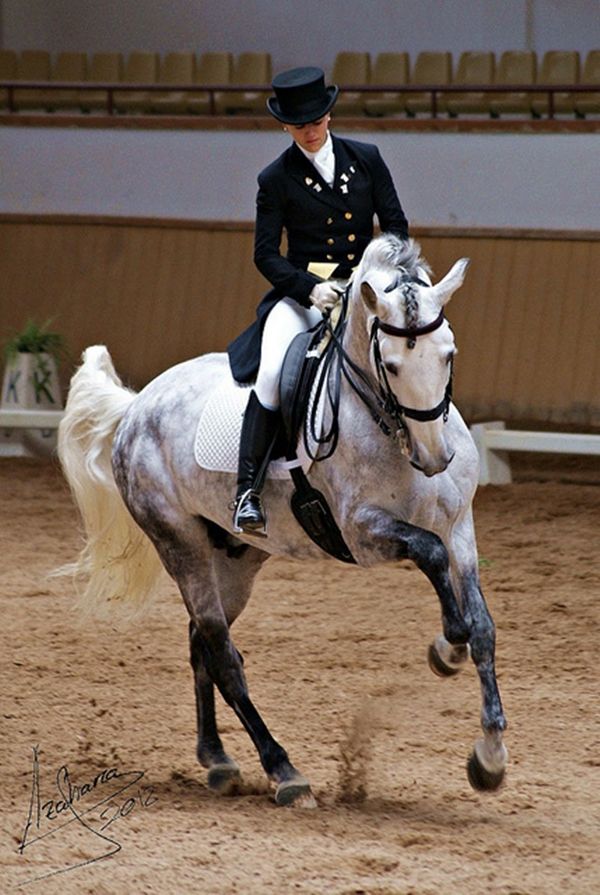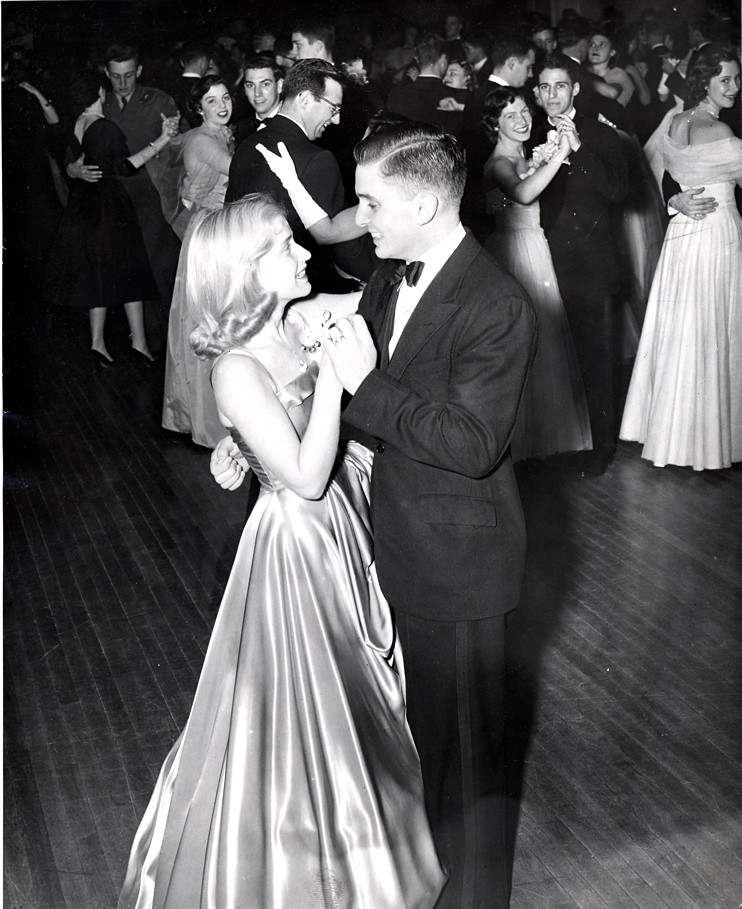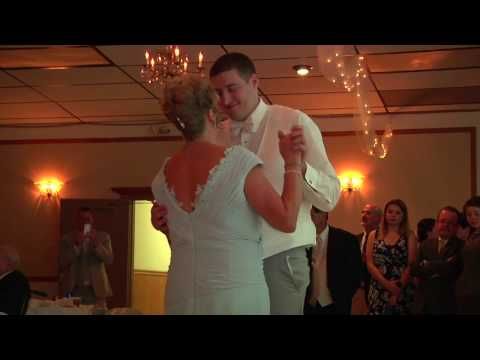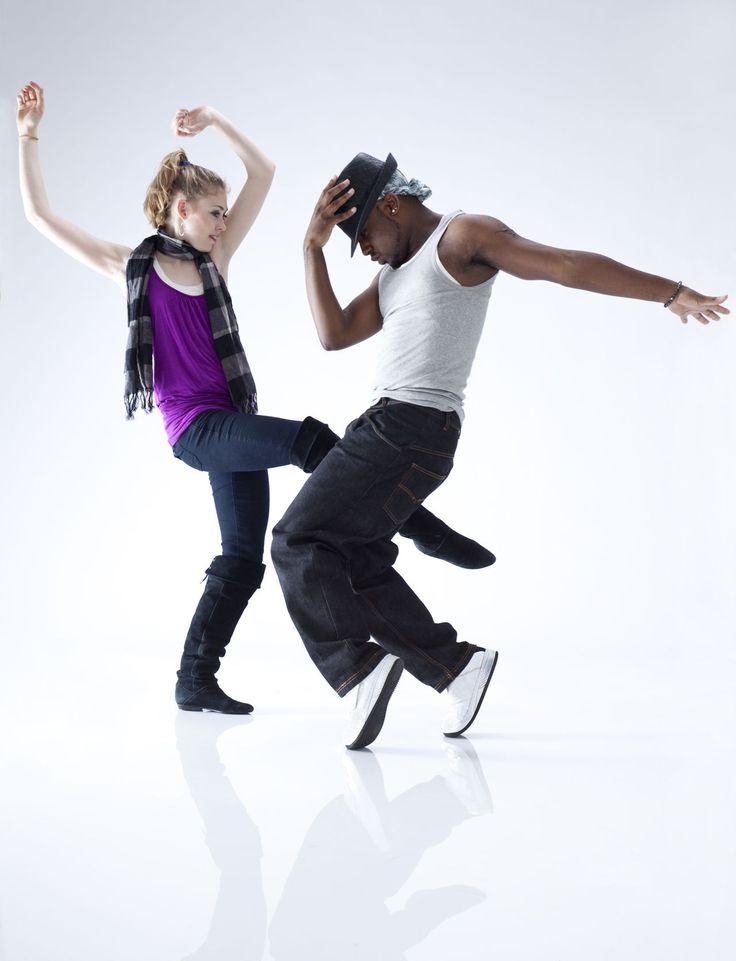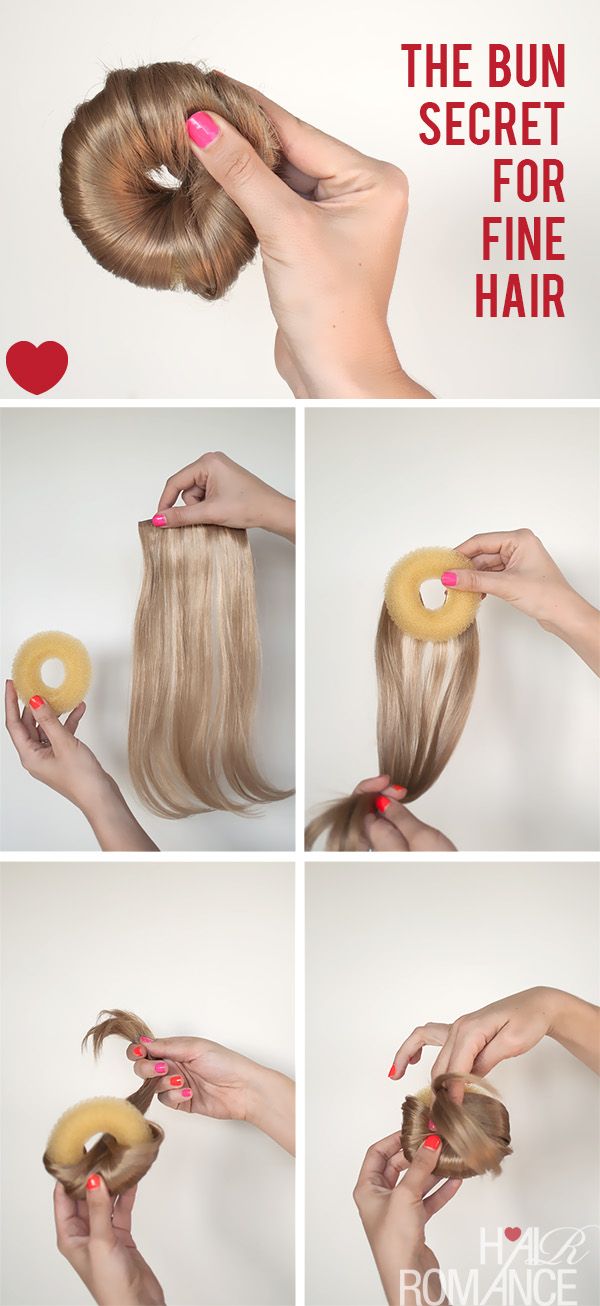How to do the horse dance
Dressage: How to make a horse dance
Published
Image source, Lewis Carrier
Image caption,Lewis Carrier says dressage isn't something "you can just do"
By Sam Gruet
Newsbeat reporter
For some, Olympic dressage is that sport where an athlete sits on a horse and makes it dance. For others, it's a lifetime of training and dedication.
That's the case for Charlotte Dujardin - this week she became Great Britain's most decorated female Olympian, winning bronze in the individual dressage event at Tokyo 2020.
But what does it take to win an Olympic dressage medal? And more importantly... how do you train a horse to dance?
According to international dressage rider Lewis Carrier, "it's not something you can just do".
The 24-year-old has been riding horses since he was six and is hoping to compete for Team GB at the 2024 games in Paris.
"Training a horse to do that takes years of experience," he tells Radio 1 Newsbeat.
"It's like learning to dance. It's technique. It's teaching a horse how to move a certain way and how to use their body in a certain way."
- Dujardin bronze sets British record
- Adam Peaty: How to think like an Olympic champion
- I beat an Olympian... when I was younger
It's one of the reasons the athletes competing in dressage can be older than those competing in other non-equestrian sports.
Like Great Britain's oldest Olympian at the games Carl Hester, who, aged 52, is part of the medal-winning dressage team.
His first Olympics was way back in 1992 in Barcelona.
Image source, Getty Images
Image caption,Experience pays - Carl Hester's the oldest Olympian at Tokyo 2020 and won a bronze this week
As well as needing years of experience, dressage athletes can also benefit from a bit of Star Wars force, Lewis says.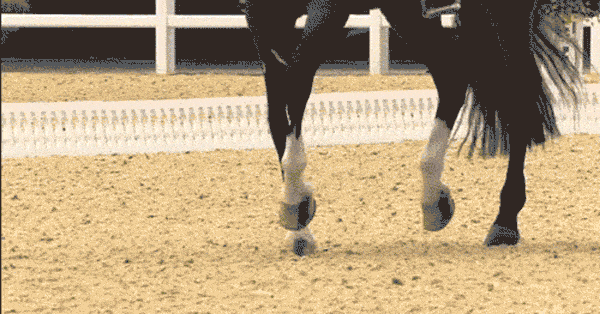
He likes to imagine dressage like a Jedi power - an invisible force that lets those trained in it control things with their mind.
"It's so much about feel. It's so hard as a trainer to teach someone, it's just something you feel one day and you have it. You have the feel," he says.
Every movement in dressage is triggered by an aide from the rider, Lewis adds.
"These horses have trained with these riders for such a long time. They know exactly what the rider is asking for when they do it. They have to be moving like Olympians. Nothing can look forced, it has to look harmonious between horse and rider."
The rules
- Dressage at the Olympics is made up of three tests: qualifying, team and individual
- At an Olympic Games, each nation can put forward three teams of three horse and rider combinations
- Each rider and horse combination takes it in turn to perform a range of movements, scored by seven judges
- Everyone competes in the qualifying round.
 The top eight teams (each including three riders) make it to the team final
The top eight teams (each including three riders) make it to the team final - The team final is decided by adding all three scores - giving the top three teams gold, silver and bronze
- The top 18 riders from the team final then compete in the individual final
Top athletes like Charlotte Dujardin train with several horses, so animals are ready to take over if needed.
Horses can start competing aged eight and normally carry on until they're 19 or 20, Lewis says.
So do these hard-working horses get their own medals?
Not exactly - but Lewis says if they win they celebrate with lots of sugar cubes and carrots.
Image source, Łukasz Kowalski
Image caption,Lewis says training a horse to dance is a technique
"It's hard to explain to an animal how good they have done," he says.
"[But] these horses know the riders so well and they know when they've done a good job."
A rule states that horses have to be part-owned by someone from the nation they're representing, but according to Lewis the blood lines are mostly Dutch and German-bred - as that's where dressage is so big.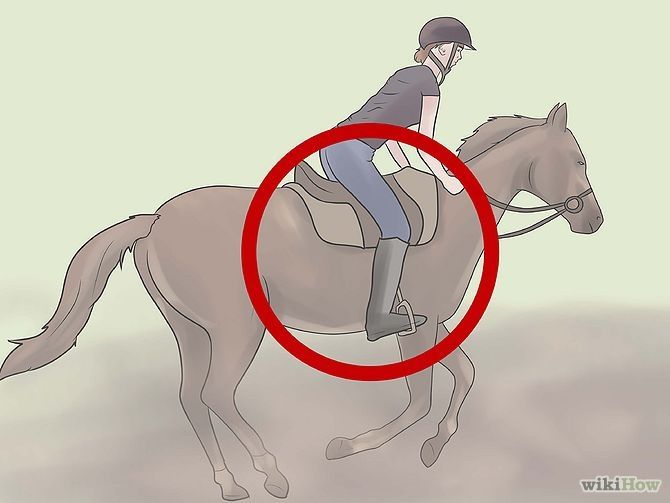
Image source, Getty Images
Image caption,Lottie Fry (right) won a bronze medal with Charlotte Dujardin and Carl Hester
One of the stand out Team GB stars in dressage at this games has been 25-year-old Lottie Fry, who is technically still a junior.
She was the youngest medal-winning rider in the team final - taking home bronze alongside Carl Hester and Charlotte Dujardin - which Lewis says is "massive."
"For her to be at an Olympic Games at 25 years old, halfway around the world, and to pull off three incredible tests is absolutely huge. You have to have so much calm about you to ride a test like that. It's really impressive."
Follow Newsbeat on Instagram, Facebook, Twitter and YouTube.
Listen to Newsbeat live at 12:45 and 17:45 weekdays - or listen back here.
How to Train a Horse to Dance
By Danee Rudy | Updated August 11, 2017Things You'll Need
Snaffle bridle (reins not needed)
Lead rope
Saddle or surcingle
Side reins
Dressage whip
Treats
Area with good footing and a wall or fence
Electrical tape or rubber band
When asking your horse to dance, stand tall and be focused.
 When giving your horse a break, relax and take your direct focus off your horse. This helps her know if she is supposed to be working or not.
When giving your horse a break, relax and take your direct focus off your horse. This helps her know if she is supposed to be working or not.You can try tapping anywhere on the lower leg. Some horses respond to low taps, others are best tapped near the hocks.
The Spanish walk--in which the horse moves forward with a flourish from the front legs--is an effective trick to teach prior to piaffe. It also involves tapping the legs for a response but is a little easier for the horse to learn.
Warnings
Working near horses can always be dangerous, especially when asking the horse to be exuberant. If he gets afraid or upset, have a professional help you before engaging in any further piaffe training.
The piaffe is a trot-like movement that a horse performs on the spot, and looks like a dance. A competition-quality piaffe takes years of training and strengthening for the horse to lower his haunches, shift his weight over his hindquarters, and raise his forehand, but any horse can learn the footfalls of a piaffe through trick training.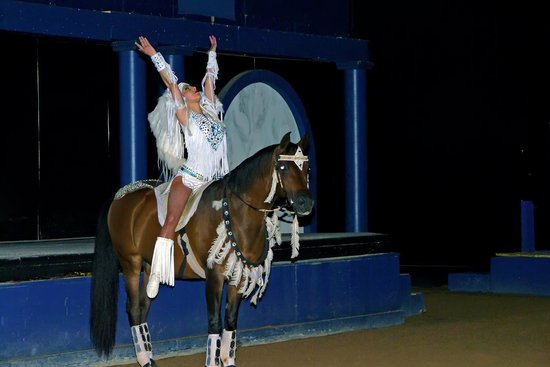 Even some Grand Prix dressage horses have begun piaffe this way.
Even some Grand Prix dressage horses have begun piaffe this way.
Warm up your horse with basic groundwork. Lead your horse at a trot and back her up. Move her shoulders and hips and ask her to put her head up and down.Your horse needs to respect you as her leader and understand that when you apply pressure she must figure out your request for the pressure to be released. If your horse does not move off feel easily-- or worse, moves into pressure--start with easier challenges and come back to the piaffe once your horse has learned to be a puzzle solver.
Put a halter on your horse and attach a lead rope. A simple halter and lead are sufficient for beginning piaffe training, but as you progress you will want to use a bridle and saddle or surcingle to connect one side rein on the horse's right side. You can use both side reins if you find it to be easier. The side reins connect from the ring of the snaffle to the girth or surcingle on the same side about 9 inches below the horse's back. Put a lead rope on the left snaffle ring. Tie her tail up and secure it with a rubber band or electrical tape so the tail is not in your way.
Put a lead rope on the left snaffle ring. Tie her tail up and secure it with a rubber band or electrical tape so the tail is not in your way.
Stand your horse so the wall or fence is on his right. Stand on his left side near his shoulder or barrel. You need to be able to reach his hind legs with the dressage whip. Tap his hind left leg until he lifts it, then quit tapping and offer praise. Repeat this until your horse understands your request. If he lifts the leg nicely, or holds it up a little longer, give him a treat. You want the horse to immediately lift his leg as high as his fetlock and hold it for about two seconds. Repeat with the right leg; it is best to tap the back of the leg, but you can tap the front if you cannot reach the back of his right hind leg.
Work in sessions lasting no more than 10 minutes. It may take weeks until your horse gives consistent responses. If your horse gets frustrated and kicks out, ignore the bad behavior and reward only the desired behavior.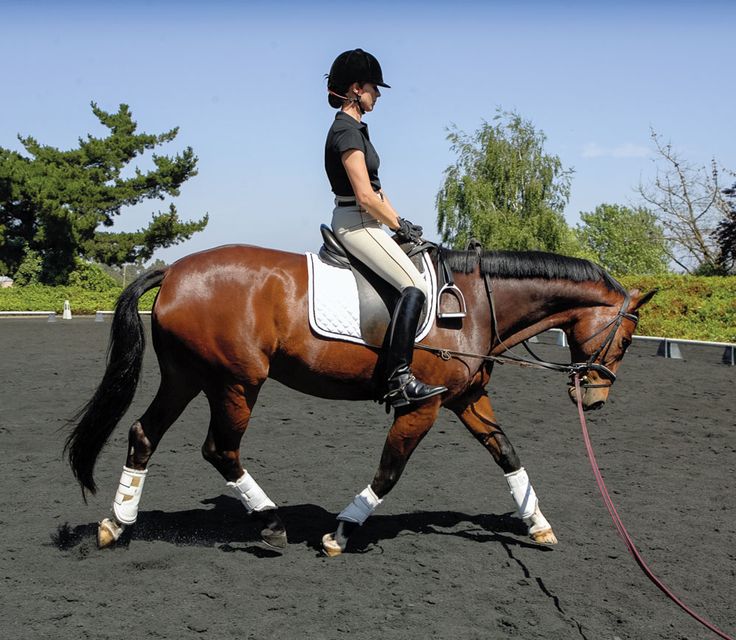
Put the bridle, surcingle or saddle, and side reins on your horse. Ask your horse to lift left, right, left and then praise. You want his response to be quick. If you ask the horse to keep going, he will quit trying, so be happy with left, right, left until he does it very well.
Trot him forward in-hand (leading the horse) a few steps after each repetition to energize him and make him think of the trot sequence of foot falls.
Tap your horse's haunches. Tap gently with the dressage whip to encourage her to creep forward just enough to get her front feet moving. You can also tap her front legs to give her the idea; her legs move in diagonal pairs, so tap the front left as the hind right leg is lifting. Lift her head if you need to get her lighter on her front feet, or lower her head if she gets tight and nervous. If she does one step that looks like a dance, reward her immediately and give her a break. Once she understands your request she will dance for longer periods of time to earn that carrot.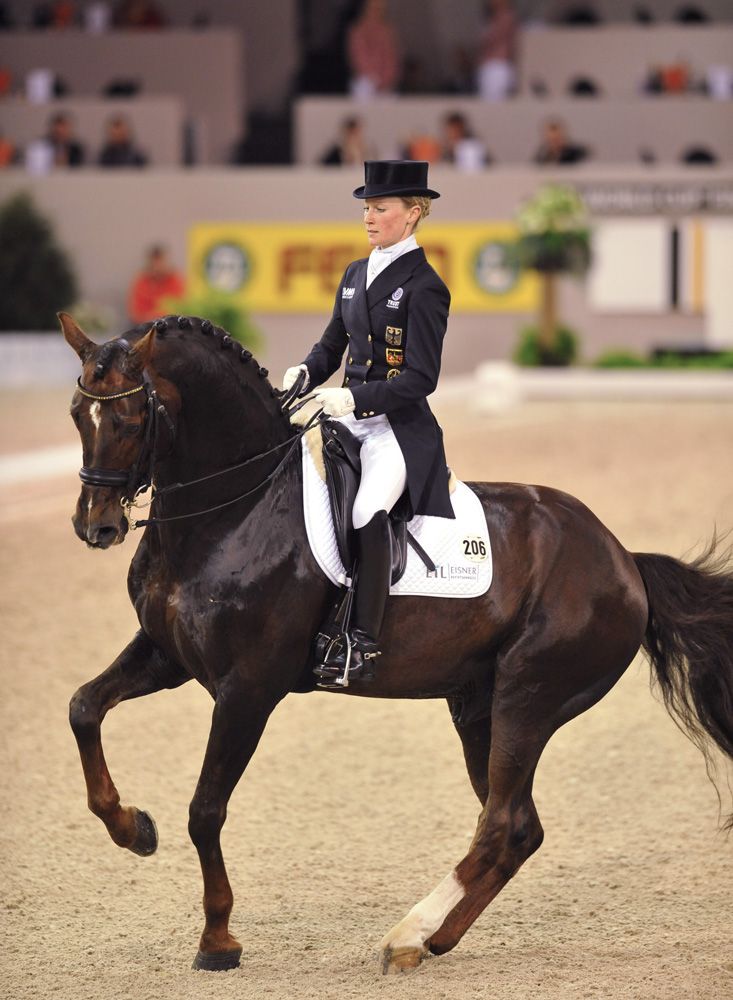
Tips
- When asking your horse to dance, stand tall and be focused. When giving your horse a break, relax and take your direct focus off your horse. This helps her know if she is supposed to be working or not.
- You can try tapping anywhere on the lower leg. Some horses respond to low taps, others are best tapped near the hocks.
- The Spanish walk--in which the horse moves forward with a flourish from the front legs--is an effective trick to teach prior to piaffe. It also involves tapping the legs for a response but is a little easier for the horse to learn.
Warnings
- Working near horses can always be dangerous, especially when asking the horse to be exuberant. If he gets afraid or upset, have a professional help you before engaging in any further piaffe training.
How are dancing horses trained? | Noti Horses
During festivities and equestrian events, you can't help but stop to watch the dancing horses.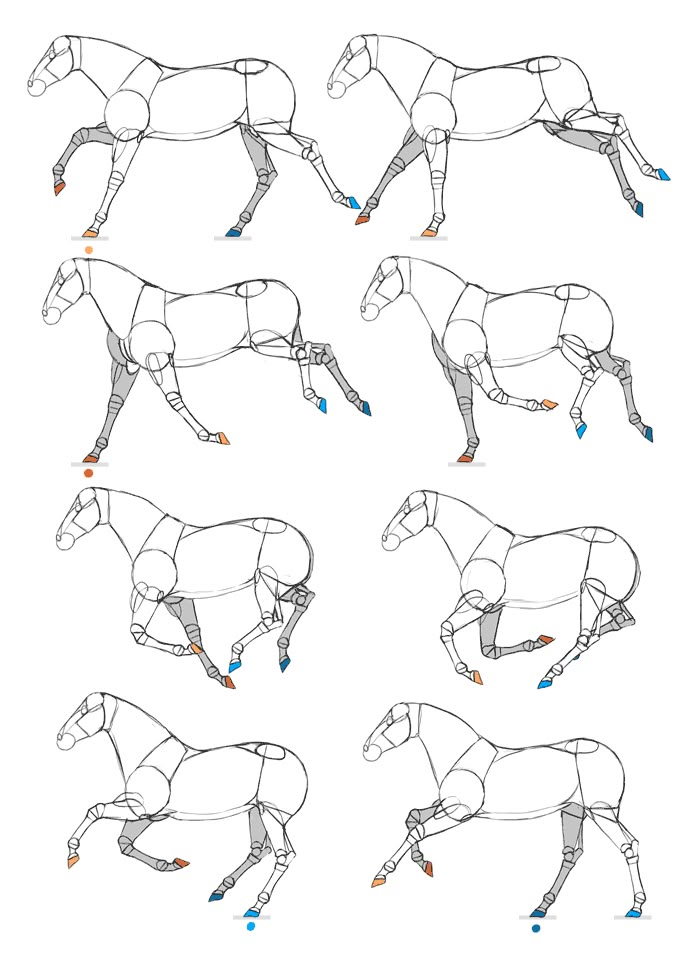 The trust that animals have in their trainers, the respect that both often show each other. This is a real spectacle that everyone should see at least once in a lifetime.
The trust that animals have in their trainers, the respect that both often show each other. This is a real spectacle that everyone should see at least once in a lifetime.
But how do you teach a horse to dance? What does it take to make her dance? If you want to teach a friend how to move to the rhythm of the music, don't stop reading.
Index
- 1 What is piaffe?
- 2 How are dancing horses formed?
- 3 Dancing horses of Spain
What is piaffe?
To teach a horse to dance, the first thing to do is to find out what a piaffe is. Also. This movement is similar to the trot of a horse moving over a point. . Based on years of training, the horse naturally lowers the hips, transfers weight to the hindquarters, and raises the right side to follow the music. This way they can compete in the best piaffe competitions in the world.
But this does not mean that only some horses can dance. In fact, anyone can learn the piaffe by learning a trick that must always end with the animal prize . Similarly, respect and patience are key to making the horse feel eager to learn and not afraid of possible reprisals. We must never forget that they are animals, that they have feelings and therefore deserve our respect.
How are dancing horses formed?
As soon as this is known, it's time to get to work, or rather, sit on our horse 🙂. So we will follow this step by step:
- The first thing we do is take him for a walk . Short walk. The point is not to tire him, but to relax him a little. It is known that it is much easier to work with a calm animal than with a nervous one. The first will pay attention to us; the other chooses not to.
- Then, We will fit it and pull out . We will move his shoulders and hips and ask him to raise and lower his head.
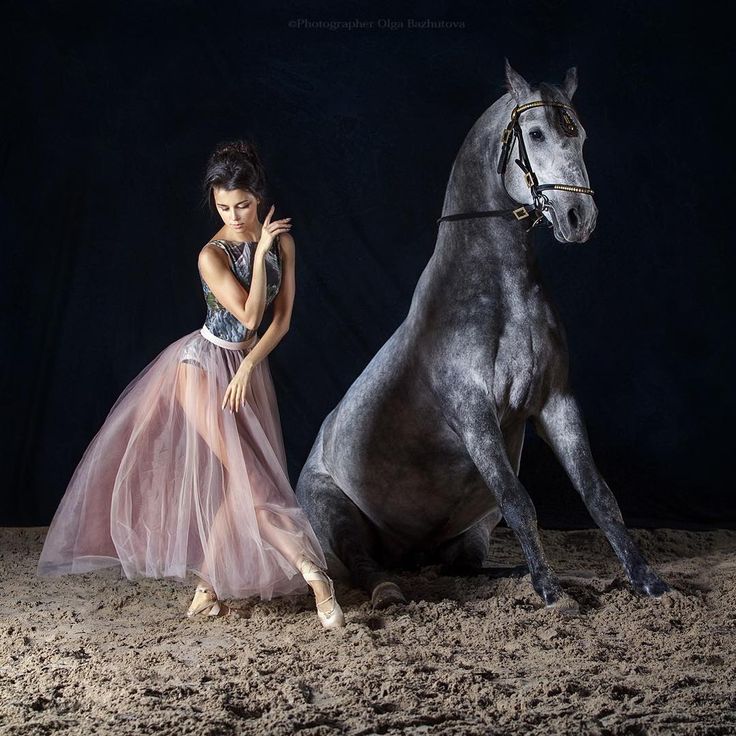 We will do this several times, giving you a few seconds of rest between exercise and exercise.
We will do this several times, giving you a few seconds of rest between exercise and exercise.
In the event that he does not do this, or if it is difficult for him to do so, instead of asking him so much, we can ask him to stand up and just shake his head; then we put him down and then ask him again to stand up and move his hips. Thus, if you ask him one thing at a time, he will probably have a much easier time learning what we are teaching him. - Now put a halter on the horse and tie a rope . In the beginning, a simple halter and leash will do; later we can use the bridle and saddle to connect one side of the rein to the right side of the horse. To make it easier for us, we can use both side reins, which we will connect from the loin ring to the circumference of the same side about 23 cm below the back of the animal. We will tie his tail with an elastic band so that he does not interfere with us.
- After that, stop the horse so that the wall or fence is on the right.
 We will put it on the left side . With the help of a dressage whip, we must reach his hind legs. We touch the left hind leg until it stands up, and then we offer it a prize. Repeat the same with the right hind leg.
We will put it on the left side . With the help of a dressage whip, we must reach his hind legs. We touch the left hind leg until it stands up, and then we offer it a prize. Repeat the same with the right hind leg. - Next, we put on a bridle or saddle, as well as side reins. We will ask you to move left, right, left and reward you with . The answer should be fast, but the same, if we see that it costs you, we will come back and slow down. It's not about making the horse perfect: perfection doesn't exist. It's about teaching him something while trying to have fun, and he won't do it if we ask him for more than he is capable of doing at the moment.
- Finally, what we will do is touch his front legs . If you are nervous, we will let you lower your head or lower yourself; so calm down. On the contrary, if we see him animated, we will lift him up to make him feel proud. If he behaves well and, above all, takes a step like a dance, we will give him the prize he deserves and let him rest.

Lessons should last about ten minutes. , no longer needed. Don't let your horse feel frustrated as it will lose interest in learning to dance. In addition, I insist, we must be very patient. It may be weeks before we see an animal learning this.
Spain's Dancing Horses
In Spain we are very fortunate to be able to enjoy a show of dancing horses. These animals are the real stars of many festivals and events, especially in Andalusia. , for example, the Festival of Horses, which is celebrated in Jerez, or in my city of Ses Salines (Mallorca) during the festival of San Bartomeu (end of August).
With Spanish music and costumes typical of the eighteenth century, dancing horses and their riders dance their wonderful equestrian ballet using dressage and cowgirl techniques, hooks, handwork and carousels.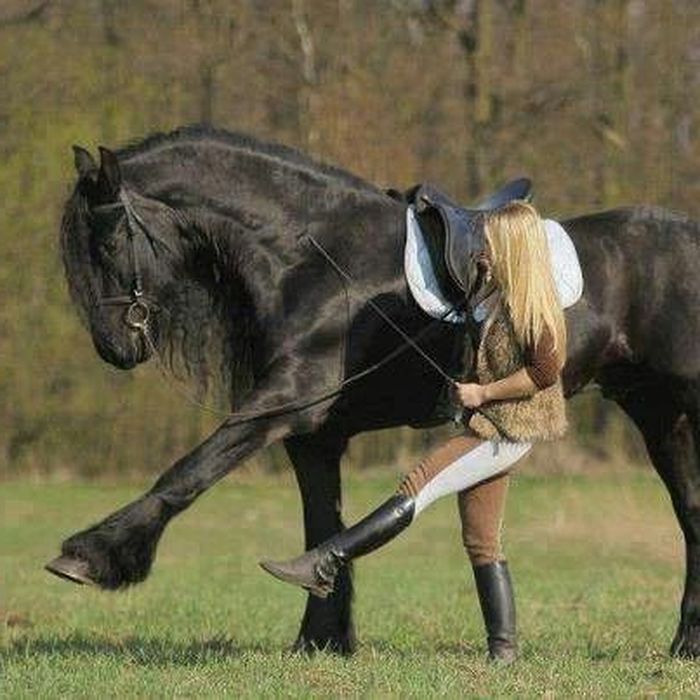
Did you know how dancing horses were trained? Do you dare to teach a friend to move to the rhythm of the music? 🙂
The content of the article complies with our principles of editorial ethics. To report a bug, click here.
You may be interested
Tango with a horse - learning to listen to each other. Conflict resolution through the techniques and philosophy of tango!
Revelations from tango lessons.
This article is about two people: about a man and a woman, about a man and a horse, about a man and the Universe.
I can no longer keep so many useful insights from you that come to me during tango lessons! A few days ago, my husband and I returned from a three day 4 th Cyprus Tango meeting. We have been taking tango lessons for the second year now and my box of precious truths that I discover in tango and apply in relationships and work with horses is already full, it's time to tell you everything!
Revelations from tango lessons.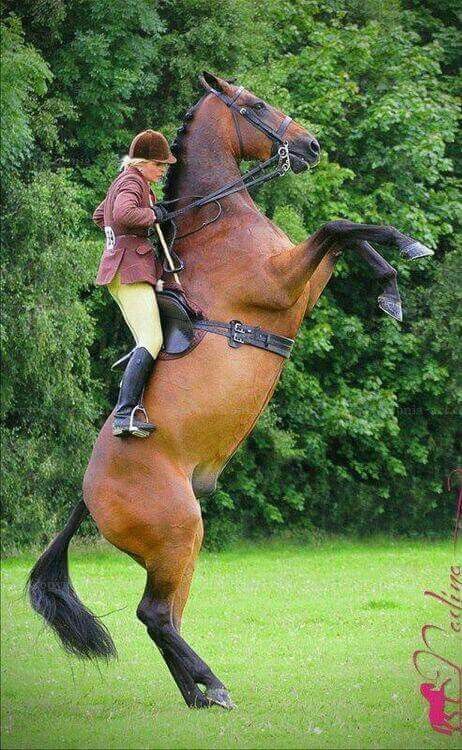 Photo by Pavel Ermilov
Photo by Pavel Ermilov
I express my deep gratitude to our tango teachers Jonatan and Helly, Marcos, Dionisis and Chloe, Horacio Godoy and Cecilia Berra, Vaggelis and Marianna, Ziad and Jihane!
I dance with horses and tango lessons helped me feel like a horse, that is, led, as in tango, a man leads a woman, a woman answers and follows, and in a dance with a horse - a man leads the horse, and the horse answers and follows his signals. The horse is the woman in tango, the man is the partner of the horse. It may seem funny to you, but from this point of view, many conflict points in interaction with horses become clear, as well as the keys to solving them!
Body language, emotional state, energy, state of mind, personalities, balance and collection, and most importantly intention… are truly international languages that we can take from dance and apply to interact with horses! International, because Nature gave them to us... How simply and elegantly all the fundamental rules in tango can be transferred to the rules of relationships with a horse and even interaction with the World! I'm not talking about the discovery of two worlds - men and women! My husband and I have been together for more than 20 years and now, as it turned out, we are rediscovering each other! It is the same with horses - you can be the owner of a horse for many years, but not know what true connection, balance and dialogue are in harmony with each other, when you become one, when you enjoy every moment in motion and this dialogue turns for you both into a magical action . .. All roads lead to the Looking Glass - Wonderland. And today I will tell you about one of them… So, revelations from tango lessons.
.. All roads lead to the Looking Glass - Wonderland. And today I will tell you about one of them… So, revelations from tango lessons.
Let's run through the Looking Glass! Photo by Pavel Ermilov.
Programs and mutual requirement to comply. Return to basic principles.
When we first started taking tango lessons, we decided to learn a dance for the wedding and after learning it, we almost had a fight, a feeling of frustration arose and we abandoned tango lessons for many years. Why? We were taught the programs - everyone learned their part and demanded from the partner the ideal performance of their role ... But ... we were not in dialogue! Any mistake of a partner - me or my husband - and the whole structure of the dance collapsed, we did not know how to improvise, because we did not know how to listen and did not hear each other. Dancing for us was hard work in tension and stress, not pleasure! We didn't understand that it was necessary to feel the simplicity and learn to enjoy the basic steps and moments of mutual rebalancing, and not the fancy tricks and “pas” that were performed by “falling on each other”.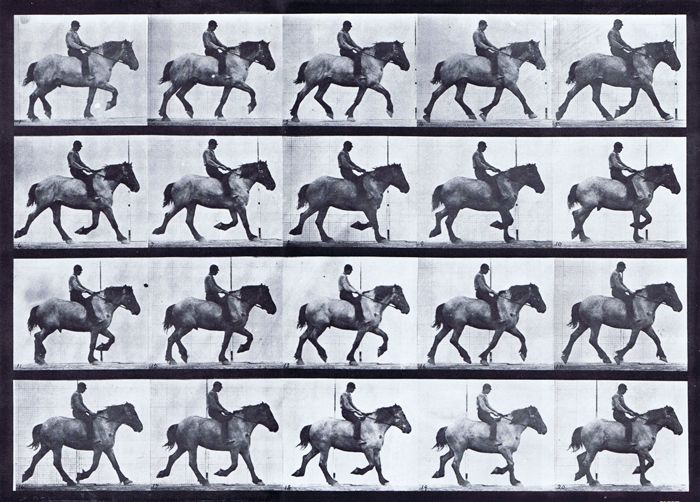
Familiar horse situation? A step away from the program - the trainer's dissatisfaction or an increase in the demand to perform what was planned and, as a result, the horse has a feeling of frustration that he was underestimated or not good enough, that he does not have the right to express his opinion or report discomfort and agonizing waiting, when is it everything will end! Conversely, if a person does something not according to the program, the horse does not know how to behave with him and can be dangerous! For example, a horse was taught to the "program" to always follow a person only on a halter, then without ammunition it will be at a loss to perceive the signals of a person or simply ignore him and even be indignant! Most horses endure when the session is over or systematically perform their part of the "program", in anticipation of a release and a well-deserved rest.
But many of us dream that horses also enjoy working and interacting with us! Then the return from them will be greater, the work will be safer, and such work with the horse will bring more joy and satisfaction to both the person and the horse! I'm not talking about health, when everything is done in harmony and then exactly the right muscle groups work . .. There will be no overstrain with resistance, but on the contrary, it is the enjoyment of harmony and balance!
.. There will be no overstrain with resistance, but on the contrary, it is the enjoyment of harmony and balance!
How to come to this? Just like my husband and I returned to tango lessons. We began to study the basic steps with the curiosity of the pioneers, groping for a general balance, ease of understanding. First you need to build a foundation, learn the alphabet. What is included in the ABC of tango and can really help us with the horse? Treasure box open!
Magic is everywhere… Photo by Pavel Ermtlov.
Basic principles:
- Application, acquaintance. At one of the tango lessons, Vaggelis and Marianna asked us to portray a couple He is James Bond, She is Monica Bellucci. Laughter is laughter, and these images were supposed to convey dignity, confidence, calmness, gentleness, respect, grace. If you make faces in front of a mirror, you can quite understand horses - after all, from birth they behave so amazingly dignified and graceful! And indeed, in my seminars, I ask you to portray queens, princesses and kings.
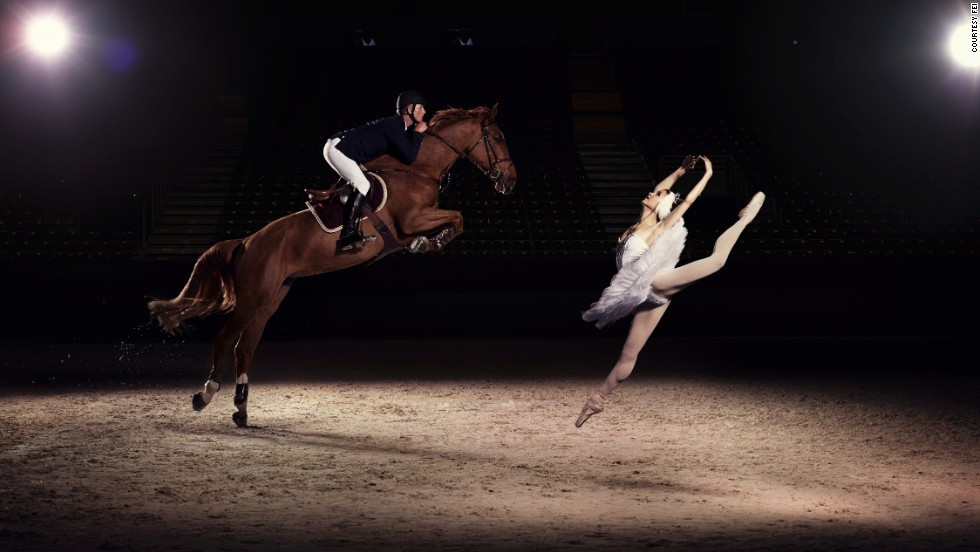 And then the horse immediately becomes interested in you and it doesn’t even occur to her to be familiar with you! To do this, you just need to: do not lower your head, take a breath and straighten your shoulders, smile!
And then the horse immediately becomes interested in you and it doesn’t even occur to her to be familiar with you! To do this, you just need to: do not lower your head, take a breath and straighten your shoulders, smile! Application, dating… worthy of each other's attention… Photograph by Pavel Yermilov.
- Care. The man dominates according to the rules of tango, and in a pair of man-horse, as a rule, the man leads. So, I really liked how Vaggelis gently stroked Marianna on the back, saying "You admire this woman and now you take care of her, every step you take will take care of her." Here it is! This is the key to keeping the horse soft in our hands, in any interaction! We do not demand because the horse "should", we offer or ask or even "force" to do something precisely because we are in a state of "love and care"! It can also be a parental state, as I often tell you in seminars, when mom or dad puts the child to bed - he has no choice not to sleep, but their hands are as soft as they are insistent and you want to succumb to this bliss! Caring is the key to dominating influence!
Caring for You… Photo by Pavel Ermilov.

- Hugs, say hello. At the lesson "Tango salon" sophisticated Cecilia Berra told us about how a man and a woman meet in tango, how to position the bodies correctly relative to each other. I was struck by the simplicity and genius of this action - we have to imagine that we haven’t seen a friend for a long time, go up to him and start hugging, swaying, as is done when meeting after long partings, and already through this hug, arrange the hands of partners like in a dance. At the lesson, we walked and hugged strangers, someone strained and did it “for show” and then it was impossible to sway, and someone hugged so sincerely, with such naive simplicity that it became so good, warm, like at home with a loved one and then the bodies themselves began to sway to the beat. I remember how before class I clean and hug the horse, how warmth and tenderness begin to flow between us, how we tune in to the same wave ...
It is very important to say hello to a horse and it is just as important that you do it sincerely and give all your attention to the horse without a trace, forgetting about everything in the world, rejoicing at this new meeting! Then exactly those channels open through which your dialogue will pass - without clamps in body language, without jerks, without bursts of impulse, in attention and trust.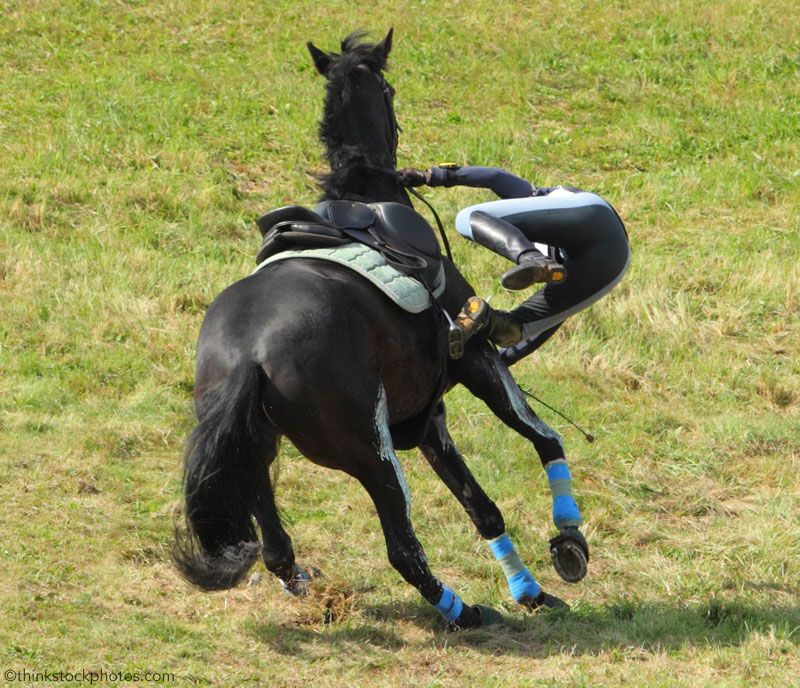 In unity there can be no conflict or resistance...
In unity there can be no conflict or resistance...
Embrace. Photo by Pavel Ermilov.
- Co-tuning - wiggle. Before starting to dance tango, and indeed any dance, a man needs to make sure that the woman hears him, understands his signals, for this, “swaying” is used in tango until the movement of both partners becomes synchronous, then the man can start dancing, that is, to change the balance already in other directions. This stage with the horse is also what I call co-tuning or joining, in this stage we can simply walk beside the horse, adjusting to his step or follow him on the circle, adjusting to the rhythm of his movement and then, as soon as you feel that you and The horse is one whole, you can start the interaction - an invitation, a change of gait, and so on - any of your actions will now be heard by the horse!
Attunement. Photo by Pavel Ermilov
In fact, it doesn't even matter what you start doing, the main thing is together! Walking, hugging, running, cleaning, walking, grazing, some simple action that synchronizes your bodies and minds for an easy transition to more complex actions.

Attunement - simplicity in Trust ... Photo by Pavel Ermilov
Causes of problems and keys to their solution.
I, being a woman, that is, a guided partner, like a horse, can tell you the whole range of negative sensations that a horse can feel if it is inexperienced (unbroken) or if the partner is inexperienced and learns by itself. Speaking on behalf of a woman, I will speak on behalf of a horse, agreed?
Let's use the example of tango to look at the causes of the frustration of the horse, its condition, consequences and the keys to solving these problems.
Causes:
The feeling of a broomless horse in a dialogue with a master differs from the feeling of a broomless horse in a dialogue with an inexperienced student. With a master, it is a lack of understanding of subtle signals and the need to hear clearer and brighter and slower explanations, but also timidity due to inexperience.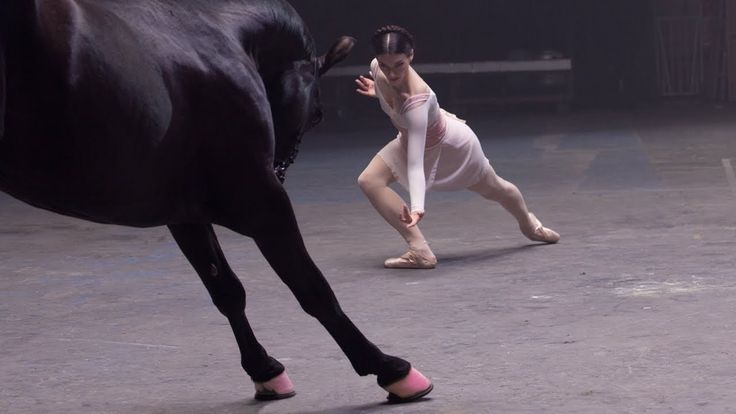 If the master at the same time tries to communicate with the “broken horse”, as with an experienced partner in the dance, then he will fail - the female horse will not recognize light signals and will get confused in the requirements to respond quickly, which will lead to the states described below (for example, resistance or stupor). Ignorance by the woman (horse) of the rules of the game leads to a delay in answers from the woman (horse) or to incorrect answers. At the same time, the master knows how to create and can create conditions such that a woman will inevitably give the right answers, both in terms of balance, and body language and condition. To do this, the master (man, man) needs to give soft consistent signals, amplifying them slowly, for explanation and balance, create clear conditions so that the woman (horse) is convenient to take a step exactly where the master wants! That is, to create conditions so that the choice of women (horses) is inevitably correct!
If the master at the same time tries to communicate with the “broken horse”, as with an experienced partner in the dance, then he will fail - the female horse will not recognize light signals and will get confused in the requirements to respond quickly, which will lead to the states described below (for example, resistance or stupor). Ignorance by the woman (horse) of the rules of the game leads to a delay in answers from the woman (horse) or to incorrect answers. At the same time, the master knows how to create and can create conditions such that a woman will inevitably give the right answers, both in terms of balance, and body language and condition. To do this, the master (man, man) needs to give soft consistent signals, amplifying them slowly, for explanation and balance, create clear conditions so that the woman (horse) is convenient to take a step exactly where the master wants! That is, to create conditions so that the choice of women (horses) is inevitably correct!
I understand you, I am with you… Photo by Pavel Ermilov
With an inexperienced partner, a woman (horse) will interact until the cup of patience overflows! An inexperienced partner makes mistakes and “blunts” - in tango - steps on her feet, “drops” a woman, hurries, gives conflicting signals, does not give any signals, acts without intention - all this confuses a woman (horse) and, in the end, leads her into a sense of frustration. It seems to her that nothing is working out or that she is so “stupid”, as a result, this all leads to irritation. Want to run away! Have you imagined yourself in the place of a man - a man? This is us, my dears, with our horses, when we ourselves are learning! The horse wants to run away or resist if you are in a hurry, giving conflicting signals, late in reacting, abruptly changing the balance of the horse, acting without intention, not giving any signals, but trying to decide what to do next, and the horse is “waiting” in confusion ... How to be? I promise you that there is a way out! And it's brilliantly simple!
It seems to her that nothing is working out or that she is so “stupid”, as a result, this all leads to irritation. Want to run away! Have you imagined yourself in the place of a man - a man? This is us, my dears, with our horses, when we ourselves are learning! The horse wants to run away or resist if you are in a hurry, giving conflicting signals, late in reacting, abruptly changing the balance of the horse, acting without intention, not giving any signals, but trying to decide what to do next, and the horse is “waiting” in confusion ... How to be? I promise you that there is a way out! And it's brilliantly simple!
Causes of states. Grisha responds to my provocation. Photo by Pavel Ermilov.
States: so, all these states are felt by the horse during the ride or during the first dialogues with the person: confusion, fear, uncertainty, tension, resistance, imbalance, feeling of frustration, irritation. I also experienced these states while learning tango with my husband, as he also studied, as well as a lot of stress at milongas (tango meetings) when there are a lot of people around and everyone is looking at you, how you dance, and you you don’t even know how to just maintain balance when the movement begins together .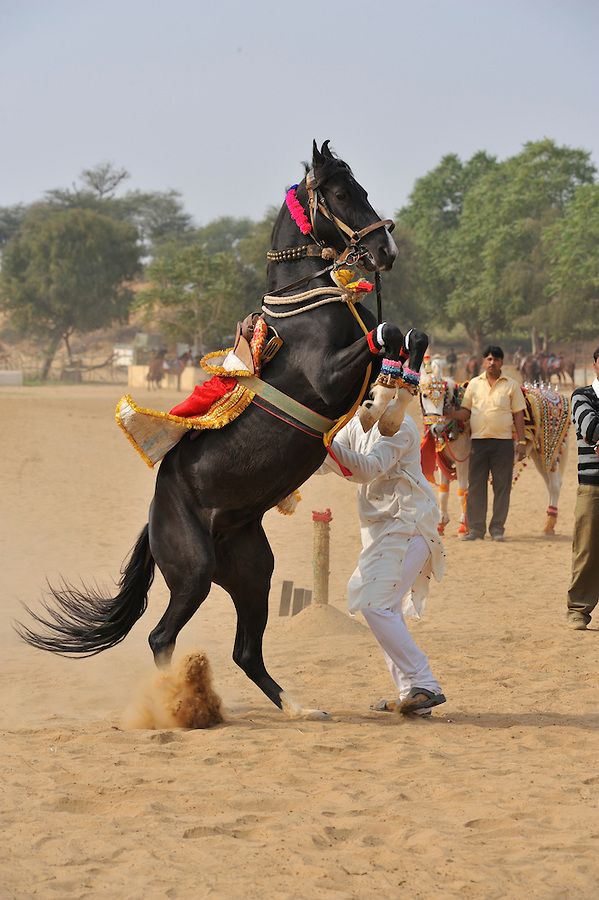 .. Balance in thoughts, emotions and between bodies ... I felt like the same horse that was hurriedly explained some tricks and rode on it, forgetting to explain how to deal with your own balance and how to learn peacefully negotiate with a partner…
.. Balance in thoughts, emotions and between bodies ... I felt like the same horse that was hurriedly explained some tricks and rode on it, forgetting to explain how to deal with your own balance and how to learn peacefully negotiate with a partner…
Conditions and mirroring, Grisha wants to be the third in the dance. Photo by Ppavl Ermilov
Consequences: the consequences in tango are an attempt to pull a man by the arm, by the shoulder, to put weight on the man, to “hang himself” on his shoulders, an attempt to dominate (lead) or just a desire to run away, vanity in reactions, vanity and fast movements, so as not to fall, because in slow movements both partners fall on top of each other, a stupor and, in the end - an explosion! Sounds like some situations with horses? When the horse falls on the person, presses with his shoulder on the bit, when the horse tries to invest in the rein on the horse, when the horse tries to dominate the person by resisting the signals, when the horse carries the person on horseback in order not to fall, due to a shift in balance forward when the horse offers immediately a hundred actions or vice versa completely begins to ignore the person when the horse just explodes and runs away!
Keys to the solution.
The keys to solving all these problems are very simple, we just need to remember two things - joy and a sense of balance!
Joy and a sense of balance in free play. Photo by Katerina Lipanina.
Key #1. We are not in a hurry, we do not demand, we enjoy nonsense!
In order to experience a sense of joy, enjoyment of every moment, it is enough for us to experience a sense of satisfaction from each simple lesson passed, that is, to receive positive experience in “small steps”. First, take as a principle the statement “Every experience is good!” To do this, you should allow each other to do stupid things and mistakes, that is, do not rush into demands, and act very sensitively in order to feel every moment and listen, listen, listen to each other! A man (man) should increase the requirements as he is sure that a woman (horse) answers the simplest ones with ease. That is, increase the complexity of movements gradually, as you understand the previous ones.
For starters, you can just stand together beautifully! Photo by Katerina Lipanina
Any dance, woven from very simple steps, but made with a sense of each other, clearly, in harmony, will look much more beautiful than an extravaganza of extreme movements that turned into noise!
If you look at the tango from the side, some couples dance emphatically slowly, as if forgetting about the whole world around, only “question-waiting-answer” through body language, directly savoring every moment…
And with a horse, you can just stand... or walk... or run or lie down... just breathe into each other's faces and be so together, so one, that those around you involuntarily freeze in amazement... some cry when they see just such a moment of unity...
We are not in a hurry, we do not demand, we enjoy nonsense. Photo by Pavel Ermilov
Key #2. The balance of each one.
But before this wonderful unity, each of the partners needs to figure out their own balance! In tango lessons, we are asked to imagine that you are being pulled by the top of your head to the ceiling, then the body turns into a certain axis, a rod around which all the movements of your body take place.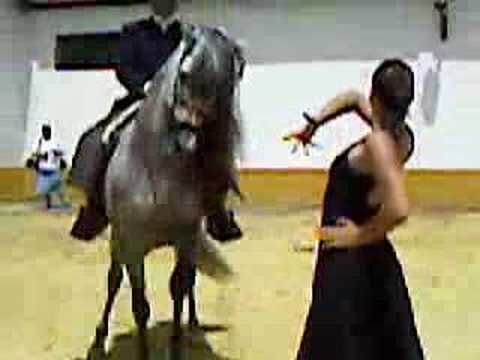 Keeping your own balance in tango is if a man and a woman stop touching each other and do not fall. In any movement they don't need each other's help to keep from falling, no! Their hugs are necessary only for signal interaction, expression of feelings and support!
Keeping your own balance in tango is if a man and a woman stop touching each other and do not fall. In any movement they don't need each other's help to keep from falling, no! Their hugs are necessary only for signal interaction, expression of feelings and support!
Balance of each separately. Photo by Katerina Lipanina
With horses - a person and a horse are stable, respecting each other's boundaries without resistance or collapse. Then any signal or stimulus is not overcoming the partner's resistance, but a proposal to act together in one direction!!!
Key #3 Balance together. Groping and playing.
When we have learned to maintain balance independently of each other, respecting personal boundaries, we can begin to find a common balance. This can also be done in the game, allowing each other to make mistakes and fall, melting away any tension with laughter.
In search of balance, it is important to remember that a sudden change in balance can lead to partner resistance, so as not to fall! How often, if a person asks a horse to turn sharply, it resists or rests even more! But this is not harmful to the horse! She only does this to keep her balance! Therefore, it is so important when searching for balance to find balance points together, and not to provoke falls and resistance! Softer, gradually making the signals thinner rather than coarser.
Balance together. Photo by Pavel Ermilov
Key #4. Just keep going. Interrupting the dialogue is a waste of time.
You should not stop the dialogue for bickering and start sorting things out, let alone get personal! “You did the wrong thing, why did you step in the wrong direction, etc.” — Be in the present, in the dialogue here and now, in the flow, in order to get as much experience as possible in terms of balance with each other!
It's so stupid to stand in the middle of a crowd of dancing people in love and find out why we stepped on each other's toes ... I was in that situation and I don't want to go there again ... you just need to close your eyes and surrender to the flow of movement, carefully allowing each other to make mistakes ... and the horse will appreciate it!
We learn to listen to each other in the flow - further and further, without interruption, but absorbing the experience. We try, we try, we try!
Just go on…Photo by Pavel Ermilov
Key #5 Gathering and collection points.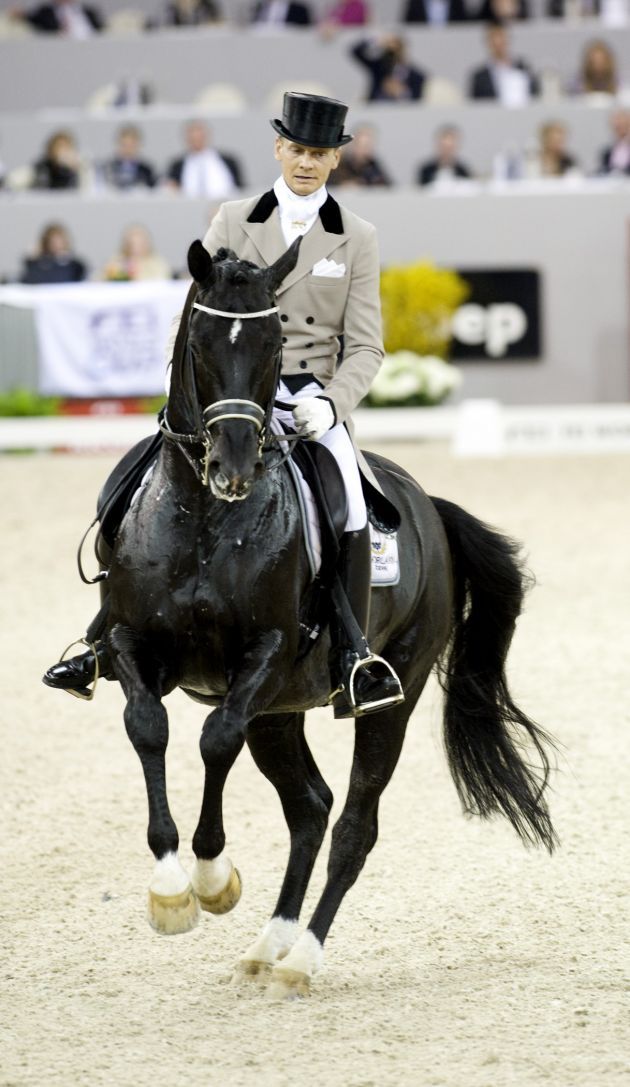
It is noteworthy that in tango a woman is expected to be ready to follow the man, or rather, together with the man in any direction, but this ability is very similar to the state of gathering! Just like a horse that can take off in any direction, with any impulse and also stop abruptly from any gait, a woman must be plastic and compliant in the hands of a man.
Gathering and collection points…Photo by Pavel Ermilov.
How to achieve this? We have already talked about the balance of each partner - in order not to interfere with each other's movement, not to fall on each other, let's say there is such a balance. How to move together "in the collection"? There is one little secret - every movement or change of movement goes through the collection point - a man cannot, having directed a woman back, turn her halfway in the other direction! Each movement, step ends with a point of stable balance! In tango, this means that after each step the woman brings her feet together to be ready to take the next step in any direction! Even if it is done quickly, these balance points are present in every movement. It's just like a horse bringing in his hind legs to be ready to stop at any moment, or, conversely, to jump out of place or release his front legs to pirouette to the side!
It's just like a horse bringing in his hind legs to be ready to stop at any moment, or, conversely, to jump out of place or release his front legs to pirouette to the side!
Collection and collection points. Grisha performs the Shoulder inward exercise at the trot Photo by Pavel Yermilov
What conclusion can we draw from this rule for horses? That it is very important to pay attention to the stop and start of movement! Let there be not very many movements or steps next to the horse or in a circle, but by teaching the horse to stop perfectly at any moment from any gait, you will enlist the attention of the horse and its stability in the movement itself and at the same time the readiness to stop at any moment to change then direction or movement!
Key #6 Everything matters.
At the master class of Ziad and Jihane, we could not understand how I could not rotate around my axis completely with my body, performing the “Ocho” element, but turn my shoulders towards my partner and twist only my hips. It turned out that it's all about a small detail! The partner should not have limited my movement with the hand supporting the back. It's just the lack of a light touch! And already the amplitude of the movement "flows" in a different direction! In this example, I remembered how important it is for a horse to feel comfortable in motion, when a person does not simultaneously press on the “gas and brake”, does not give contradictory signals by turning the shoulders, blocking the horse, but by urging it with his hands. Or just a small detail in a state where a person asks to lay down a horse, and instead of laying down, the horse explodes and is carried away! This is how a pause of tension works… Outwardly, nothing happens, but for a horse, literally everything matters when it is in dialogue with a person. If you want clean responses, give clean signals without noise!
It turned out that it's all about a small detail! The partner should not have limited my movement with the hand supporting the back. It's just the lack of a light touch! And already the amplitude of the movement "flows" in a different direction! In this example, I remembered how important it is for a horse to feel comfortable in motion, when a person does not simultaneously press on the “gas and brake”, does not give contradictory signals by turning the shoulders, blocking the horse, but by urging it with his hands. Or just a small detail in a state where a person asks to lay down a horse, and instead of laying down, the horse explodes and is carried away! This is how a pause of tension works… Outwardly, nothing happens, but for a horse, literally everything matters when it is in dialogue with a person. If you want clean responses, give clean signals without noise!
Everything matters… Photo by Pavel Ermilov
Key No. 7 If done, then in full force. Collection quality…
At the lesson "Tango technique for women" the beautiful Chloe was demanding of us, her students. She uttered an interesting phrase "The difference is 10 centimeters if you try to pull your leg while stepping or just walking." If the movement is not done at full strength, then purely outwardly the movement will not be as effective, but the muscles will not be fully involved, which means they will not be sufficiently trained to maintain balance. A woman and a man must be partners worthy of each other - for this it is necessary to develop their bodies. Just as a person cannot train only a horse, a person simply needs to be a worthy partner of a horse in order to move on an equal footing with it, as a whole, and even more so to sit on it. What does "worthy" mean? This means not to interfere with each other's movement! What does it mean not to interfere? It means to be physically able to match the partner - balanced, soft, mobile, to have time to match the rhythm, without clamps and resistance, that is, in the collection! This applies to both partners!
She uttered an interesting phrase "The difference is 10 centimeters if you try to pull your leg while stepping or just walking." If the movement is not done at full strength, then purely outwardly the movement will not be as effective, but the muscles will not be fully involved, which means they will not be sufficiently trained to maintain balance. A woman and a man must be partners worthy of each other - for this it is necessary to develop their bodies. Just as a person cannot train only a horse, a person simply needs to be a worthy partner of a horse in order to move on an equal footing with it, as a whole, and even more so to sit on it. What does "worthy" mean? This means not to interfere with each other's movement! What does it mean not to interfere? It means to be physically able to match the partner - balanced, soft, mobile, to have time to match the rhythm, without clamps and resistance, that is, in the collection! This applies to both partners!
Let's run and dance together! Photo by Pavel Ermilov
In horses, work on the collection is carried out in four directions - straightening (gymnastics), relaxation, pumping the necessary muscles and balance.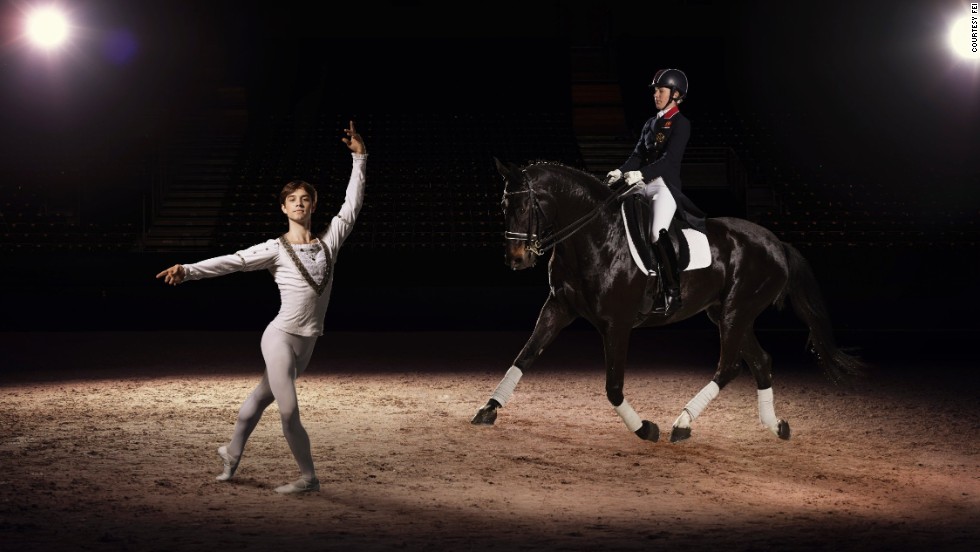 Nature did not invent anything new in tango either. Strive to perform exercises with a horse with small repetitions, but with high quality, diligently, with all your heart! Otherwise, the interaction will be blurry and unbalanced...
Nature did not invent anything new in tango either. Strive to perform exercises with a horse with small repetitions, but with high quality, diligently, with all your heart! Otherwise, the interaction will be blurry and unbalanced...
How much work on yourself!
Key number 7 Picking up and intention.
There is a wonderful expression "Carry on the wings of love." I would also call this state of captivating - mentally and physically - directing and picking up "on the fly" - in order to move in sync. When a man wants to take a step forward, he cannot take that step to crash into a woman and thereby change her balance. It turns out not tango, but bowling or even billiards, because this way you can drop all the dancing couples around! To move, a man needs to captivate a woman with his intention, also changing the balance in the right direction, but that's all! Then, making sure that the woman also changed the balance and begins to walk, the man, as it were, picks up the woman “on the fly”, merging with her in this one step into one whole.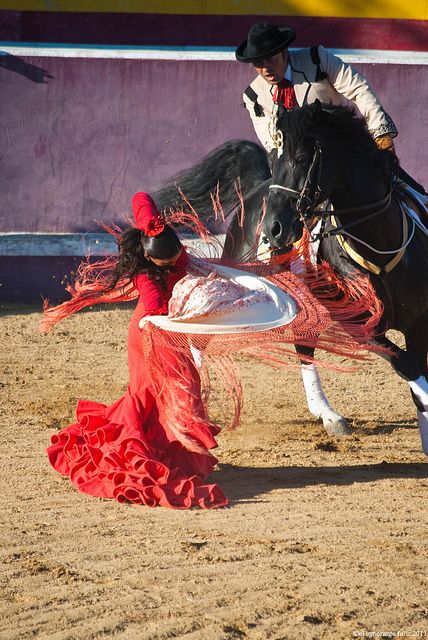 Sounds great right?
Sounds great right?
Picking up and intention… Photograph by Sergey Khudyakov.
The same with horses! I swear! At the lesson of the beautiful Cecilia Berra, I happened to be in the role of a man! It was a lesson in tango technique for women and we switched roles to understand what the men were doing to us. Well, I managed to move my female partner when I imagined that she was a horse and we were making concessions to physical pressure! How wonderful it was! I trained my sense of intention on horses and my unusual "horse" - so easily understood my intentions to go forward, backward, sideways! As for my role as a woman - a horse, I can also say for my part that the horse does not understand the impact of changing the balance without intention - you can just fall on the spot or rest against it. But when a man, for example, wants to avoid a collision or take a woman out of a corner or dance around a table, these intentions are very easily understood by a woman!
So, be sure to come up with a goal for your horse and it will be clearer to him why move there and why change the balance, in which direction! And why run like that? Even if these goals are fictitious, such as “They are handing out sweets!” or "Let's catch up with the cabinet!"
And when the horse starts moving, pick it up and fly on the wings of love!
We pick each other up and fly! Photo by Katerina Lipanina
Monologue or dialogue?
We often hear that a man leads in a pair dance. We often hear in the horse world that a person must become a leader for a horse, be able to dominate. But then it turns out that the dance is a monologue! And the woman (horse), just like an obedient puppet on strings, carries out the orders of the man (leader)! Is it really? Is it so in life? Not! Dance is a dialogue, and a man and a woman - a man and a horse - are partners. There may be disagreement in the dialogue, a proposal of one's own behavior and as a result - unity, an agreement on integrity, reciprocity, or, in case of complete disagreement, parting! For a man and a horse, in the case of successful "negotiations", this will be joining and then interacting on the same wavelength, for a horse it is voluntary, for a person it is easy and pleasant.
We often hear in the horse world that a person must become a leader for a horse, be able to dominate. But then it turns out that the dance is a monologue! And the woman (horse), just like an obedient puppet on strings, carries out the orders of the man (leader)! Is it really? Is it so in life? Not! Dance is a dialogue, and a man and a woman - a man and a horse - are partners. There may be disagreement in the dialogue, a proposal of one's own behavior and as a result - unity, an agreement on integrity, reciprocity, or, in case of complete disagreement, parting! For a man and a horse, in the case of successful "negotiations", this will be joining and then interacting on the same wavelength, for a horse it is voluntary, for a person it is easy and pleasant.
Therefore, don't think that a woman has no rights in tango, don't think that a horse has no rights! If the horse will only tolerate you as a powerful partner, he will quickly get bored with this game of “dominance”, unless you forcefully hold him, the horse will run away from such a “leader”! Recall that the leader is from the word “lead”, which means “to lead”. A horse will follow a man or a woman will follow a man’s leading hand only if she feels comfortable, safe next to him, and also if she gets a positive experience that it will be good where she is led! We have returned to the understanding of leadership as the ability to take responsibility and care. And the use of this right is only at the moment of the invitation to change the balance and only on the condition that the woman (horse) is already listening!
A horse will follow a man or a woman will follow a man’s leading hand only if she feels comfortable, safe next to him, and also if she gets a positive experience that it will be good where she is led! We have returned to the understanding of leadership as the ability to take responsibility and care. And the use of this right is only at the moment of the invitation to change the balance and only on the condition that the woman (horse) is already listening!
A dialogue, not a monologue… Photograph by Pavel Yermilov.
In other words, when interacting with horses, we do not need to constantly prove which of us is the boss, it is enough just to be in dialogue and, if necessary, just correct the direction! A horse, like a woman in tango, has the right to answer “no” to a request, explode at provocations, give freedom to her ardor when they give her the floor and even provoke a man herself!
All these provocations will not look like a quarrel or argument, but will become a fun game only when you with a horse or a woman with a man in tango comprehend the basics of respect, goodwill, balance and its change together in simple steps. Only then, increasing the speed and complexity, you can start playing with the horse and juggle various elements, tricks and play pranks with extreme “pa” legs!
Only then, increasing the speed and complexity, you can start playing with the horse and juggle various elements, tricks and play pranks with extreme “pa” legs!
Cheerful "pa" leg. Photo by Pavel Ermilov
Let's say it happened! You are a harmonious couple with a horse, like a man and a woman in tango - in balance, soft, sensitive, light, synchronous in movements near and on horseback. What's next?
Further music and its secrets ...
About the magic of rhythm and deafness.
Many thanks to Horacio Godoy and Cecilia Berra for the Music Phrases master class, this lesson helped me to look at the interaction with the horse from the outside. In my In Harmony with the Horse workshops, we sing and try to dance with horses, channeling our signals to the horse's body and mind, getting answers, and talking back to the horse - this kind of interaction is also called contact improvisation. And it looks like a surf - ebb and flow, and so on endlessly many times - in the gentle embrace of the elements. Horses are very addicted to this process and selflessly hum with surprise when we again and again drag them into new movements. But it happens that such improvisation does not work out, or something like marching under the command of the commander turns out. Turns out it's all about rhythm!
Horses are very addicted to this process and selflessly hum with surprise when we again and again drag them into new movements. But it happens that such improvisation does not work out, or something like marching under the command of the commander turns out. Turns out it's all about rhythm!
If it is not there at all, then our actions or stimuli for the horse are like phrases taken out of context - not logical and little understood. If there is a rhythm in our actions, the horse is easily led and continues the dialogue.
I liked the way Horacio Godoy described the music as if it were a painting. He said that if you look at music only in terms of rhythm, then you get just a technical rapping of the rhythm - faster or slower. It's like looking at a picture in front of your nose - you won't see all the beauty if you don't step back to look from the side!
View from the side… Photograph by Pavel Ermilov
This is what happens with us with horses - it happens, everything seems to be perfect, the horse works clearly, rhythmically, like a robot, but there is not enough soul, a lively dialogue, the character of the horse, the expression of its personality, brightness, which, by the way, is expressed in a magnificent collection! Performing only the rhythm in an exercise or movement, we become deaf to each other, as if we stopped hearing the melody, catching only the rhythm .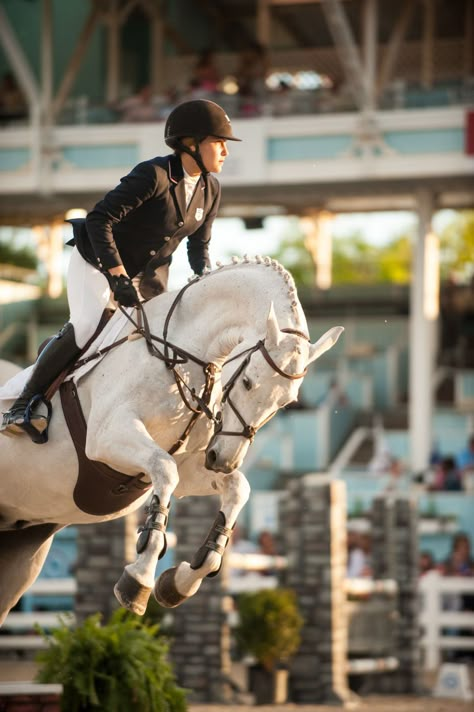 ..
..
How to look at music from the outside? It turns out that any melody consists of phrases. Oh Gods! How interesting! Our dance (occupation) with a horse, we can also designate phrases! Here in the simplest case of training - Meeting, Warm-up, Work in dynamics, Stretching, restoring breathing while walking. All these phrases, as well as in music, can be described as slow-fast-pauses.
And do you know how to make dialogue come alive in tango? Follow these musical phrases! Fast-fast-meeeeeeely! Fast-quick-slowly-slowly-pause! A pause is when everything freezes inside - horses, by the way, have such an instinctive reaction! If you freeze and hold your breath, the horse will also become quieter than water, lower than the grass and hold its breath, listening to you!
Pause and embrace...Photograph by Pavel Ermilov
And from this again you can “swim out” into improvisation, following the musical phrases slowly - quickly - quickly iiii rhythm, gallop! Here is the secret of dancing with a horse, by following, captivating the horse with music or singing, you can create your own rhythms and phrases! You can also experiment - dance emphatically slowly to a fast rhythm, dance to a slow one with improvisation of sharp movements and provocations, but this is already in the case of the maestro!
Rhythm, rhythm! Let's go! Photo by Pavel Ermilov
Do you think a horse will get bored with you if you follow the rhythm and phrases in the music, improvising differently each time? Make your horse activities more interesting by dancing to music or singing songs! Most importantly, do not be afraid to fake and make mistakes! Your laughter and relaxed state when you allow yourself to fool around will relax the horse, then his reactions will be as spontaneous as yours - natural, mirroring your signals.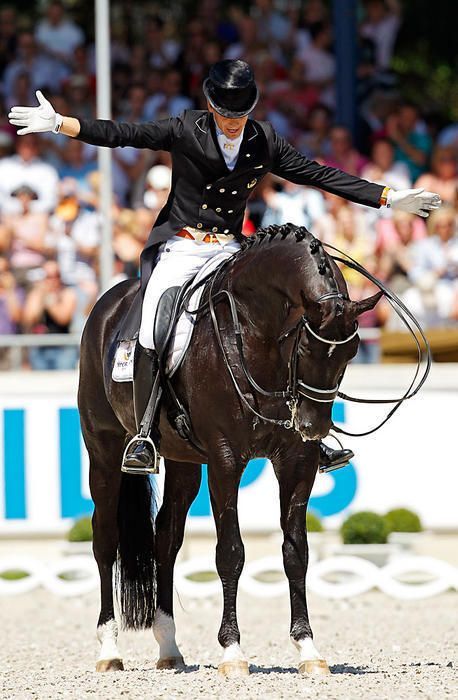 It will turn out such a musical series of your questions and answers of the horse.
It will turn out such a musical series of your questions and answers of the horse.
We are in the world and the world is around us.
At their master class Dionisis and Chloe drew our attention to the fact that some couples dance not for each other's sake, but for the audience - all movements for spectacular "pas" to impress on the outside, all the energy on the "out" ... Such a small a show... But tango is a dance of two, it is an intimacy of two worlds, it is a boiling of passions or an ardent dialogue, it is a complete concentration on each other, it is an easy game of flirting and mutual attraction. How similar it is to dialogues with a horse!
I am with you, and you are with me… Photo by Pavel Ermilov
If you start playing for the audience, the thread of the dialogue will be interrupted and the horse simply may not understand you or run away! It is necessary to forget about everything in the world, all the surrounding spectators, to be here and now “I am with you”, not paying attention to the storm, or the noise, or any interference around! What is happening there, inside, is secret, I wish you to comprehend this secret with your horse!
Everything is in the eyes…Photograph by Pavel Ermilov
Ps: I express my deep gratitude to my husband Sergey for his love and endless patience with me and my antics! I am not the easiest “horse”, it is very difficult to lead me as a woman, because I am used to dominating and leading with horses! Moreover, Sergey, I think, was the only person at the seminar who learned tango with broken ribs, and led me with all the lifts and pirouettes, no matter what! Seryozha, my applause to you!
Looking-glass exists… Photo by Pavel Yermilov.